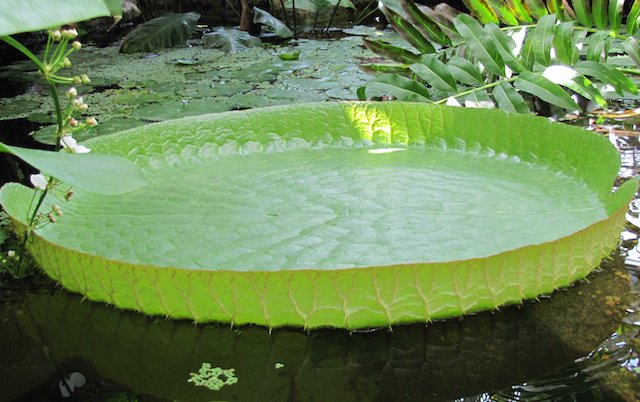Victoria amazonica - also known as Victoria regia - is an iconic species of water lily native to the shallow, slow-moving waters across the whole of the Amazon River basin.
It is renowned for its enormous circular leaves and striking flowers.
Here are some key facts about Victoria amazonica:
1. Name: The water lily acquired the name ‘Victoria’ in 1837 to honour Queen Victoria, who came to the throne that year.
In 1849, a private grower succeeded in producing the first Victoria amazonica water lily flower in England and presented this to Queen Victoria.
2. Size: Victoria amazonica is known for having the largest leaves (lamina) of any water plant. The lamina can grow up to 3 m (9.8 ft) in diameter and the submerged stalk (petiole), can reach 8 m (26 ft) in length.
This photo gives a good sense of the size of the Victoria amazonica leaves.
3. Buoyancy: Air trapped in the spaces between the ribs on the underside of the Victoria Amazonica’s leaves gives them remarkable buoyancy. The upturned edges of the leaves create a reservoir of air, enhancing buoyancy and supporting the weight of the plant.
A lily pad grown in the Belgian city of Ghent is reported to have born a load of 226 kg (498 lbs)! Whatever the truth of that, they can easily support the weight of baby caimans, lizards and wading birds.
Baby caiman wallowing on Victoria amazonica lily pad.
4. Flower: The Victoria amazonica flowers are also impressive in size and appearance. They are typically white or pink and can reach up to 40 cm (16 inches) in diameter.
The flowers are short-lived, blooming for only 48 - 72 hours and emitting a pleasant fragrance during the first night.
The flowers first begin to unfurl as the sun starts to set and can take up to 48 hours to fully open up.
All of the flowers of one particular plant will, on a given evening, all be in the female phase or all in the male phase, so that pollination must be by a different individual, precluding self-pollination.
Victoria amazonica flower in process of blooming.
5. Mutualism: Victoria amazonica water lilies have a mutually-beneficially relationship with a species of scarab beetle, which is attracted to the bright flowers and fruity smell given off by the opening buds.
At night, the flower closes trapping the beetles inside … and remains closed until the next evening. The beetles can then depart, and they do so covered in the lily’s pollen which will be transmitted to the next Victoria amazonica flower they find.
6. Adaptation: Victoria amazonica has several adaptations that help it thrive in its aquatic environment:
- Its large leaves provide shade, reducing sunlight penetration and inhibiting the growth of competing plants.
- The undersides of the leaves are covered in sharp spines as a defense mechanism against herbivores.
Upturned edges of Victoria amazonica lily pad, with spikes visible.
7. Cultural significance: Victoria amazonica holds cultural significance in the regions where it is found. In indigenous folklore it is considered a symbol of beauty, purity, and strength.
The plant has also captured the imagination of explorers and scientists throughout history.
It is featured on the coat of arms of Guyana, where it grows in abundance.
The striking coat of arms of Guyana, with jaguars, hoatzin and Victoria Amazonica water lily representing the country’s rich natural heritage.
How to see Victoria amazonica water lilies:
These remarkable, beautiful plants are abundant in the Peruvian Amazon, and so you are likely to see them during any Amazon River cruise or lodge stay.
Amazon River cruise passengers visiting lake filled with Victoria amazonica at Yucuruchi.







